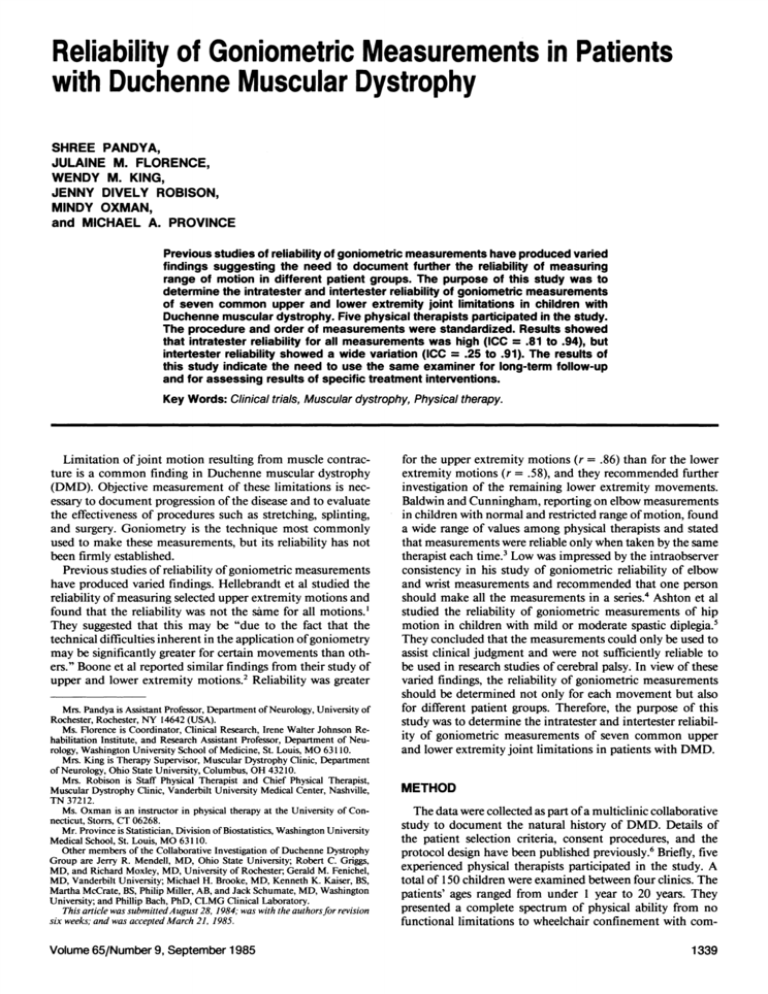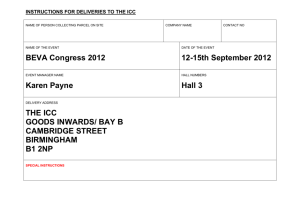Reliability of Goniometric Measurements in Patients with
advertisement

Reliability of Goniometric Measurements in Patients with Duchenne Muscular Dystrophy SHREE PANDYA, JULAINE M. FLORENCE, WENDY M. KING, JENNY DIVELY ROBISON, MINDY OXMAN, and MICHAEL A. PROVINCE Previous studies of reliability of goniometric measurements have produced varied findings suggesting the need to document further the reliability of measuring range of motion in different patient groups. The purpose of this study was to determine the intratester and intertester reliability of goniometric measurements of seven common upper and lower extremity joint limitations in children with Duchenne muscular dystrophy. Five physical therapists participated in the study. The procedure and order of measurements were standardized. Results showed that intratester reliability for all measurements was high (ICC = .81 to .94), but intertester reliability showed a wide variation (ICC = .25 to .91). The results of this study indicate the need to use the same examiner for long-term follow-up and for assessing results of specific treatment interventions. Key Words: Clinical trials, Muscular dystrophy, Physical therapy. Limitation of joint motion resulting from muscle contracture is a common finding in Duchenne muscular dystrophy (DMD). Objective measurement of these limitations is necessary to document progression of the disease and to evaluate the effectiveness of procedures such as stretching, splinting, and surgery. Goniometry is the technique most commonly used to make these measurements, but its reliability has not been firmly established. Previous studies of reliability of goniometric measurements have produced varied findings. Hellebrandt et al studied the reliability of measuring selected upper extremity motions and found that the reliability was not the same for all motions.1 They suggested that this may be "due to the fact that the technical difficulties inherent in the application of goniometry may be significantly greater for certain movements than others." Boone et al reported similar findings from their study of upper and lower extremity motions.2 Reliability was greater Mrs. Pandya is Assistant Professor, Department of Neurology, University of Rochester, Rochester, NY 14642 (USA). Ms. Florence is Coordinator, Clinical Research, Irene Walter Johnson Rehabilitation Institute, and Research Assistant Professor, Department of Neurology, Washington University School of Medicine, St. Louis, MO 63110. Mrs. King is Therapy Supervisor, Muscular Dystrophy Clinic, Department of Neurology, Ohio State University, Columbus, OH 43210. Mrs. Robison is Staff Physical Therapist and Chief Physical Therapist, Muscular Dystrophy Clinic, Vanderbilt University Medical Center, Nashville, TN 37212. Ms. Oxman is an instructor in physical therapy at the University of Connecticut, Storrs, CT 06268. Mr. Province is Statistician, Division of Biostatistics, Washington University Medical School, St. Louis, MO 63110. Other members of the Collaborative Investigation of Duchenne Dystrophy Group are Jerry R. Mendell, MD, Ohio State University; Robert C. Griggs, MD, and Richard Moxley, MD, University of Rochester; Gerald M. Fenichel, MD, Vanderbilt University; Michael H. Brooke, MD, Kenneth K. Kaiser, BS, Martha McCrate, BS, Philip Miller, AB, and Jack Schumate, MD, Washington University; and Phillip Bach, PhD, CLMG Clinical Laboratory. This article was submitted August 28, 1984; was with the authors for revision six weeks; and was accepted March 21, 1985. Volume 65/Number 9, September 1985 for the upper extremity motions (r = .86) than for the lower extremity motions (r = .58), and they recommended further investigation of the remaining lower extremity movements. Baldwin and Cunningham, reporting on elbow measurements in children with normal and restricted range of motion, found a wide range of values among physical therapists and stated that measurements were reliable only when taken by the same therapist each time.3 Low was impressed by the intraobserver consistency in his study of goniometric reliability of elbow and wrist measurements and recommended that one person should make all the measurements in a series.4 Ashton et al studied the reliability of goniometric measurements of hip motion in children with mild or moderate spastic diplegia.5 They concluded that the measurements could only be used to assist clinical judgment and were not sufficiently reliable to be used in research studies of cerebral palsy. In view of these varied findings, the reliability of goniometric measurements should be determined not only for each movement but also for different patient groups. Therefore, the purpose of this study was to determine the intratester and intertester reliability of goniometric measurements of seven common upper and lower extremity joint limitations in patients with DMD. METHOD The data were collected as part of a multiclinic collaborative study to document the natural history of DMD. Details of the patient selection criteria, consent procedures, and the protocol design have been published previously.6 Briefly, five experienced physical therapists participated in the study. A total of 150 children were examined between four clinics. The patients' ages ranged from under 1 year to 20 years. They presented a complete spectrum of physical ability from no functional limitations to wheelchair confinement with corn1339 Shoulder Abduction Fig. 1. Measurement of shoulder abduction limitation. Hip Extension Fig. 4. Measurement of hip extension limitation. Elbow Extension Knee Extension Fig. 2. Measurement of elbow extension limitation. Fig. 5. Measurement of knee extension limitation. Wrist Extension Fig. 3. Measurement of wrist extension limitation. plete dependency in activities of daily living as a result of severe muscle weakness and multiple contractures. Passive range of motion measurements were made of bilateral shoulder abduction, elbow extension, wrist extension, knee extension, ankle dorsiflexion, and hip extension in the 1340 supine position (Figs. 1-6), as recommended by the American Academy of Orthopedic Surgeons.7 Contracture of the iliotibial bands (ITB) was measured as described by Siegel.8 We placed the patient in the prone position and abducted the leg to eliminate hip flexion contracture from the tensor fascia lata. The knee was then flexed to 90 degrees and the leg adducted while we maintained pressure on the sacrum. With the patient's hip extended, we measured the angle of abduction with one arm of the goniometer on the posterior iliac spines and the other arm extending down the midline of the posterior aspect of the leg (Fig. 7). As illustrated in Figures 1 through 7, the measurements indicated the degrees of limitation from full range for each movement. The position, procedure, and order in which the measurements were made were standardized. We made the measurements with a universal goniometer and read them to the nearest 5 degrees. At no time during the study were results of previous evaluations available to the therapists. The data were collected in two parts. Each therapist examined the patient on admission to the study, at one week, and at four weeks, so that the patient was measured three times within a period of one month. These data were used to determine the intratester reliability of measurement. Intertester reliability was calculated from measurements performed PHYSICAL THERAPY RESEARCH Table Intratester and Intertester Reliability a Ankle Dorsiflexion Fig. 6. Measurement of ankle dorsiflexion limitation. Movements Intratester ICCa (n = 150) Intertester ICC (n = 21) Shoulder abduction Elbow extension Wrist extension Hip extension Knee extension Ankle dorsiflexion ITB .84 .94 .87 .85 .93 .90 .81 .67 .91 .83 .74 .58 .73 .25 ICC = Intraclass correlation coefficient. intertester reliability of measurement of the three upper extremity limitations was better than that of the lower extremity limitations. DISCUSSION Iliotibial Band Fig. 7. Measurement of iliotibial band contracture. by all therapists on the same patients on the same day. Each patient was examined individually by the therapists in separate booths with no opportunity for any therapist to observe the other therapists' measurements. During the study, 21 patients were tested in three separate sessions in group meetings. We calculated intraclass correlation coefficients (ICC) with a random effects analysis of variance model. RESULTS Intratester reliability was high for all measurements; ICC ranged from .81 to .94 (Table). Intertester reliability showed a wide variation; ICC ranged from .25 to .91 (Table). The Volume 65/Number 9, September 1985 Our study confirmed previousfindingsthat the reliability of measurements was not the same for all joints. The intratester reliability was better than the intertester reliability for all the movements measured. The intertester reliability of measurements of the upper extremity movements was better than that of the lower extremity movements. Similarfindingswere reported by Boone et al.2 For the upper extremity movements, shoulder abduction was less reliable than the movements at the elbow and wrist. Hellebrandt et al observed the same differences in their study of upper extremity measurements.1 The extremely poor intertester reliability of ITB contracture measurement (ICC = .25) was surprising because the intratester reliability was good (ICC = .81). In seeking an explanation for this, we reviewed the data again and found that the intratester reliability of ITB measurements showed a definite improvement over the study; the improvement from .68 during the first three months of the study to .83 during the second three months and .96 during the third three months suggests thefirstthree months had a training effect. A similar trend was not seen for the other measurements. Most therapists do not routinely perform ITB measurements and, hence, the repetition may have improved the skill and consistency. In spite of this improvement in individual consistency, the intertester reproducibility was still poor. We hypothesized that the force exerted by the therapist during the passive movement may be the variable that caused the goniometric discrepancy because the position and procedure were standardized. CONCLUSION Goniometric measurements are an important part of the examination of patients with DMD. We have documented the reliability of goniometric measurements in patients with DMD and have shown that the intratester reliability is high. Intertester reliability was not as high and showed a wide range for the movements tested. When goniometric measurements are performed by the same examiner, they provide a good objective measure to document progression of disease and evaluate results of treatment to reduce tightness. 1341 REFERENCES 1. Hellebrandt FA, Duvall EN, Moore ML: The measurement of joint motion: Part III—Reliability of goniometry. Phys Ther Rev 29:302-307, 1949 2. Boone DC, Azen SP, Lin CM, et al: Reliability of goniometric measurements. Phys Ther 58:1355-1360, 1978 3. Baldwin J, Cunningham K: Goniometry under attack: A clinical study involving physiotherapists. Physiotherapy Canada 26:74-76, 1974 4. Low JL: The reliability of joint measurement. Physiotherapy 62:227-229, 1976 1342 5. Ashton BB, Pickles B, Roll JW: Reliability of goniometric measurements of hip motion in spastic cerebral palsy. Dev Med Child Neurol 20:87-94, 1978 6. Brooke MH, Griggs RC, Mended JR, et al: Clinical trial in Duchenne dystrophy, I. The design of the protocol. Muscle Nerve 4:186-197, 1981 7. Joint Motion: Method of Measuring and Recording. Chicago, IL, American Academy of Orthopedic Surgeons, 1963 8. Siegel IM: The Clinical Management of Muscle Disease. London, England, Heinemann Medical Books, 1977, p 96 PHYSICAL THERAPY







